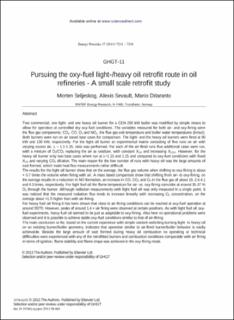| dc.description.abstract | Two commercial, one light- and one heavy oil burner for a CEN 250 kW boiler was modified by simple means to allow for operation at controlled dry oxy-fuel conditions. The variables measured for both air- and oxy-firing were the flue gas components; CO2, CO, O2 and NOx, the flue gas exit temperature and boiler water temperatures (in/out). Both burners were run on air based base cases for comparison. The light- and the heavy oil burners were fired at 90 kW and 130 kW, respectively. For the light oil burner an experimental matrix consisting of five runs on air with varying excess air, = 1.1-1.25, ratio was performed. For each of the air-fired runs five additional cases were run, with a mixture of O2/CO2 replacing the air as oxidizer, with constant XO2 and increasing XCO2. However, for the heavy oil burner only two base cases where run at =1.15 and 1.25 and compared to oxy-fuel conditions with fixed XO2 and varying CO2 dilution. The main reason for the low number of runs with heavy oil was the large amounts of soot formed, which made heat flux measurements rather difficult. The results for the light oil burner show that on the average, the flue gas volume when shifting to oxy-firing is about × 0.7 times the volume when firing with air. A mass based comparison show that shifting from air- to oxy-firing, on the average results in a reduction in NO formation, an increase in CO, CO2 and O2 in the flue gas of about 19, 2.4,4.1 and 4.3 times, respectively. For light fuel oil the flame temperature for air- vs. oxy-firing coincides at around 35-37 % O2 through the burner. Although radiation measurements with light fuel oil was only measured in a single point, it was noticed that the measured radiation flux tends to increase linearly with increasing O2 concentration, on the average about ×1.5 higher than with air-firing. For heavy fuel oil firing it has been shown that close to air-firing conditions can be reached at oxy-fuel operation at around 30/70. However, peaks of around 1.4 × air firing were observed at certain positions. As with light fuel oil oxyfuel experiments, heavy fuel oil seemed to be just as adaptable to oxy-firing. Also here no operational problems were observed and it is possible to achieve stable oxy-fuel conditions similar to that of air-firing. The main conclusion so far, based on the current experience with simple oxidant switching burning light- to heavy oil on an existing burner/boiler geometry, indicates that operation similar to air-fired burner/boiler behavior is easily achievable. Besides the large amount of soot formed during heavy oil combustion no operating or technical difficulties were experienced with any of the retrofitted burners and combustion conditions comparable with air firing in terms of ignition, flame stability and flame shape was achieved in the oxy-firing mode. | en_US |

